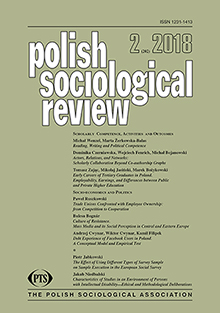Actors, Relations, and Networks: Scholarly Collaboration Beyond Co-authorship Graphs
Actors, Relations, and Networks: Scholarly Collaboration Beyond Co-authorship Graphs
Author(s): Michał Bojanowski, Wojciech Fenrich, Dominika CzerniawskaSubject(s): Sociology
Published by: Polskie Towarzystwo Socjologiczne
Keywords: scholarly collaboration; social networks; gender; core-periphery; ego-networks periphery;
Summary/Abstract: Scholarly collaboration is relatively well described quantitatively on the macro level thanks to the analyses of large bibliographic databases. At the same time, there are known limitations of the bibliometric approaches to studying collaboration in science. We argue that in order to improve our understanding of social processes operating in science it is necessary to take a more in-depth look: (1) identify kinds of actors that are recognized as potential partners in collaboration, (2) what features of collaborative relations are considered crucial for engaged actors, (3) what kinds of structures of networks composed of collaboration relations actors are embedded in, and what factors influence these structures. With 30 individual in-depth interviews (IDI) with Polish scholars we gathered detailed information about individual collaborations that allowed us to analyze collaborative ties from individual perspective and map respondent-centered networks of collaboration. Scholars identify individuals as well as teams or institutions as collaborators. They also distinguish symmetric and asymmetric collaborations. Structures of respondent-centered collaboration networks are affected by (a) leadership strategies of team principals (especially whether teams are built around positions or individuals); (b) institutional location (by making establishing external collaborations easier for scientists from bigger institutions); (c) scientific degree and recent changes in financing of science (as young scientists receive more freedom from usual organizational hierarchies by receiving substantial grants).
Journal: Polish Sociological Review
- Issue Year: 202/2018
- Issue No: 2
- Page Range: 167-186
- Page Count: 20
- Language: English

